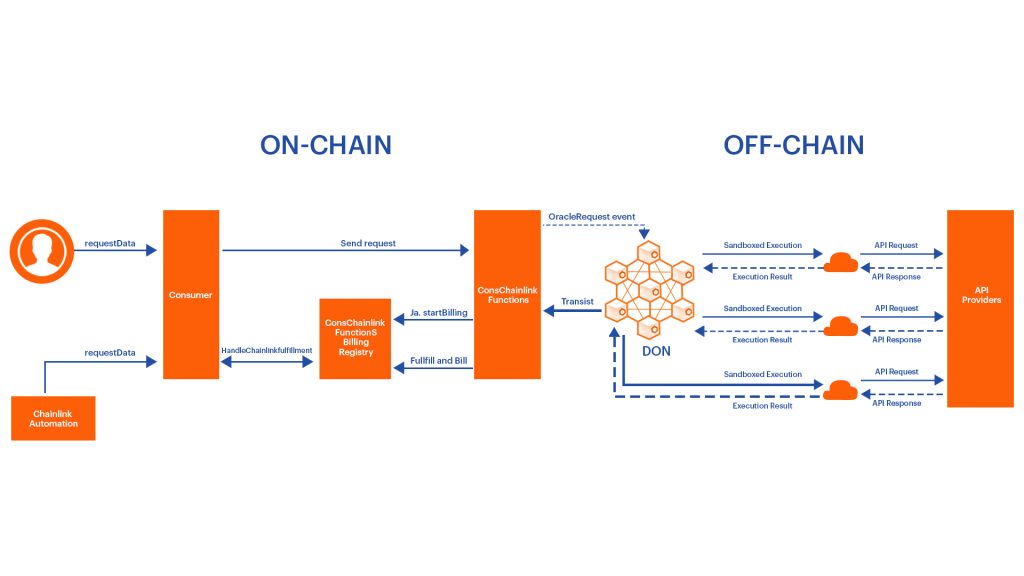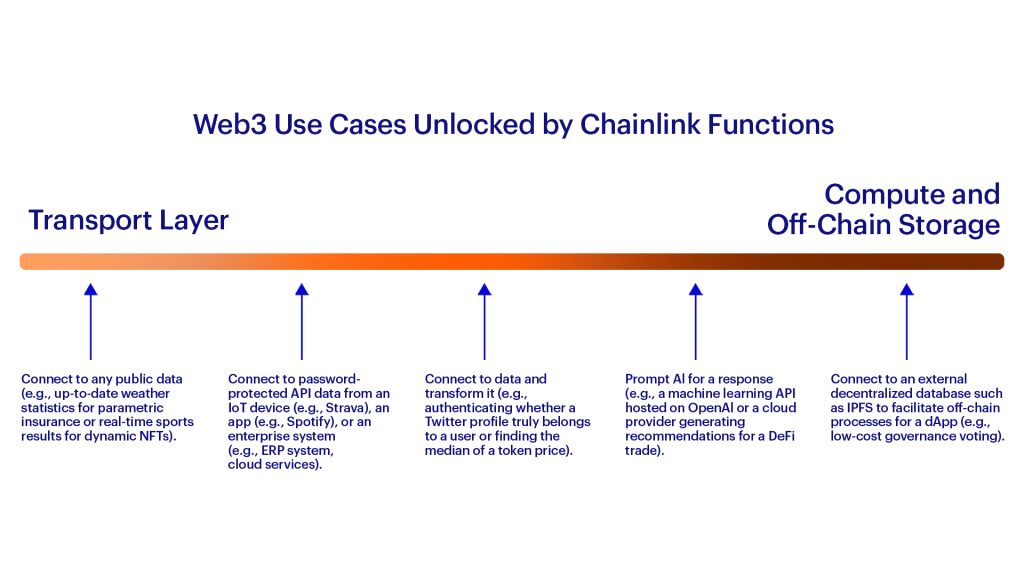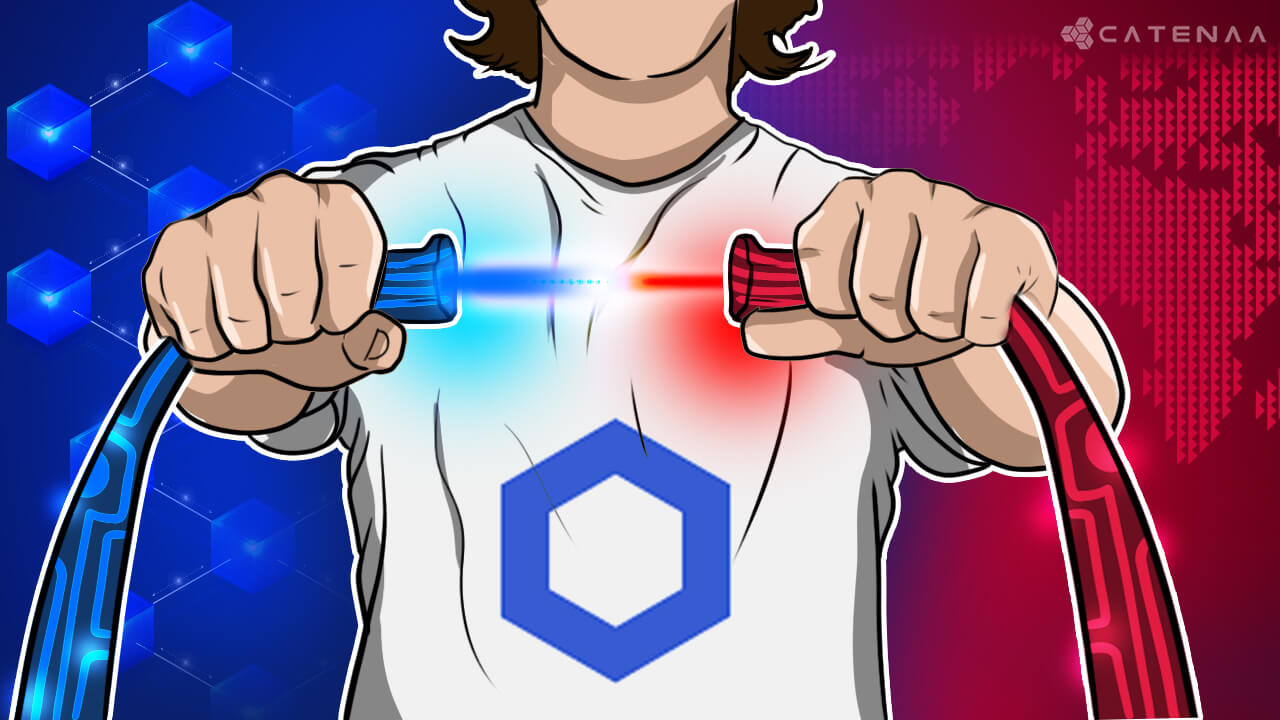Blockchain oracles are essential for connecting Web3 with real-world data. Blockchains, by design, can only access on-chain data, limiting their functionality. To overcome this, decentralized oracle networks (DONs) fetch off-chain data and deliver it to smart contracts.
Chainlink, the leading decentralized oracle network, offers Chainlink Functions. These allow smart contracts to access external APIs and perform off-chain computations. This improves scalability, cost-efficiency, and security.
In this article, we will focus on Chainlink functions, exploring what they are and how they fit into the complex world of smart contract development.
How Blockchain Chainlink Functions work?
Chainlink Functions rely on two main components:
Off-Chain Reporting (OCR) Protocol: This aggregates node responses into a single, reliable data feed.1
Decentralized Oracle Networks (DONs): Nodes fetch and process external data before transmitting it to the blockchain.

The above diagram depicts how an API call is facilitated through Chainlink functions. First, the user initiates the transaction by calling the consumer contract. Then, the consumer contract sends the request to the FunctionsOracle contract. The Functions Oracle contract then estimates the cost of the requested data and blocks the amount in the reservation balance.
Next, the Functions contract emits an Oracle request event to the DON containing information about the request. Once the request is received by the DON, each node in the DON initiates the API call on a serverless environment and receives it. The off-chain reporting protocol is then used to aggregate all the API responses, and the aggregated API response is transmitted by a DON’s Oracle node to the FunctionsOracle contract. Finally, the final cost of the request is finalized and deducted from the LINK balance.
Here, we have used an API call to demonstrate how Chainlink functions operate, but a DON can request any computation. For more in-depth information about the architecture behind Chainlink functions, click here.
Use Cases for Blockchain Chainlink Functions

Off-Chain Computing and Storage
Developers can also use Chainlink Functions to connect their smart contracts to a decentralized database like IPFS or Filecoin. This would enable the creation of off-chain computing dApps that make use of DONs as the computing layer and IPFS for low-cost decentralized storage. A developer, for example, can create a decentralized off-chain voting system for a DAO by utilizing Chainlink Functions to retrieve off-chain votes and relay the vote result on-chain to trigger a smart contract-based action.
Data Connectivity
Developers can use Chainlink Functions to connect to any public or private data API, such as fetching recent gaming or sports results or pulling metric data from Token Terminal via a Web3 protocol (e.g., protocol revenue, user fees, active users, TVL).
In addition, Chainlink Automation can serve as a complementary service. For instance, dynamic NFTs that alter according to external events can make use of Chainlink Automation to regularly verify whether updates are required. Furthermore, Chainlink Functions can be utilized to bring event data onto the blockchain when specific conditions are fulfilled.
Advanced computation
Developers can go beyond data connectivity by instructing Chainlink Functions to retrieve data and perform advanced computations on it before referencing it in their smart contract. Developers can, for example, retrieve data from a social media API, calculate sentiment, and report the transformed result on-chain to trigger an action (e.g. a user receives a limited-edition NFT).
IoT Devices and Traditional Backend Connectivity
Developers can also use Chainlink Functions to connect to password-protected IoT device data or an enterprise system to integrate Web3 protocols with existing technologies and networks. Developers, for example, can retrieve data from a smartwatch or a smart pollution sensor. They can also connect a smart contract to an enterprise ERP system like SAP to build a supply chain application or to the Stripe API to check a user’s account balance. 2
Benefits of Blockchain Chainlink Functions
- Scalable and cost-effective
Chainlink functions allow complex computations to be done off-chain securely and trust-minimized, which costs only a fraction compared to on-chain calculations. Scalability is vastly enhanced by offloading complex computations off-chain without compromising security, and decentralization.
- Seamless Access to Real-World Data:
Chainlink functions provide a seamless and secure way for smart contracts to access real-world data. By leveraging these functions, smart contracts can obtain valuable information from external sources such as APIs, databases, and IoT devices. This enables smart contracts to make informed decisions based on real-time and accurate data, expanding their functionality and use cases.
- Modularity and Reusability
Chainlink functions promote modularity and reusability in smart contract development. They are designed as modular pieces of code that can be easily integrated into different smart contracts. Developers can leverage pre-built Chainlink functions or create their own custom functions, allowing them to save time and effort by reusing existing functionality and components. This modular approach also enables the combination of multiple functions to achieve complex tasks efficiently.
- Enhanced Security and Reliability
Chainlink functions enhance the security and reliability of data inputs and outputs in smart contracts. They leverage a decentralized oracle network that consists of multiple independent oracles. These oracles collectively validate and verify the data, ensuring its integrity before it is delivered to the smart contract. This decentralized approach mitigates the risk of single points of failure and provides a higher level of security and trustworthiness for the data utilized by smart contracts.
- Versatility and Interoperability
Chainlink functions enable smart contracts to interact with various external systems and resources, enhancing their versatility and interoperability. They can fetch data from any public or private API, connect with other smart contracts, or even interact with traditional systems and databases. This flexibility allows hybrid smart contracts to integrate seamlessly with Web2 infrastructure, such as social media signals, AI computation, messaging services, etc. This enables the development of complex decentralized applications across different industries.
- Trustworthiness and Transparency
Chainlink functions contribute to the trustworthiness and transparency of smart contract operations. By leveraging decentralized oracles and reliable data sources, these functions ensure that the information used by smart contracts is accurate and verifiable. This transparency associated with blockchain reduces the need for blind trust and promotes trust in the decentralized ecosystem, enhancing user confidence in the outcomes and actions executed by smart contracts. 3
Security Considerations
- Network Connectivity – The reliance on external data sources in a decentralized Oracle network introduces a dependency on network connectivity. If the network experiences downtime, delays, or disruptions, the availability and timeliness of data for smart contracts can be affected. It’s important to consider redundancy measures, failover mechanisms, and fallback options to ensure continuous operation and mitigate the impact of network connectivity issues.
- Data Source Reliability – Decentralized oracle networks rely on multiple oracles to provide accurate and reliable data. However, if the source of the data is compromised, it could compromise the smart contract. For example, if a DON requests data from a compromised or malicious API, there is nothing the DON can do to prevent it.
- Oracle Manipulation – Decentralized Oracle networks are susceptible to attacks or manipulations by adversaries attempting to compromise the integrity of the data being delivered to smart contracts. Malicious actors might try to control a significant number of Oracle nodes or collude to manipulate the data in their favor. Network design, reputation systems, cryptographic techniques, and consensus mechanisms can be employed to mitigate such attacks and maintain the security of the Oracle network.
Future of Chainlink Functions
Currently, chainlink functions are only available in BETA and can be accessed on the Ethereum Sepolia Testnet, Polygon Mumbai Testnet, and Avalanche Fuji Testnet. 4 Once it launches on the mainnet, we can get a better idea of its performance and impact in the Web 3 space.
Currently, a few hundred thousand developers are creating various types of applications on blockchain networks. However, there are approximately 30 million developers worldwide. To make blockchains as commonplace as the cloud or even AI, we must continue to remove the barriers that exist in the Web3 developer experience. One of the fundamental issues that Chainlink Functions addresses is the lack of access to API data. By linking existing Web 2 infrastructure to Web 3, Chainlink Functions opens up a whole new world of possibilities for Web3 developers.
- thirdweb.com: https://blog.thirdweb.com/guides/chainlink-functions/[↩]
- blog.chain.link: https://blog.chain.link/introducing-chainlink-functions[↩]
- blog.chain.link: https://blog.chain.link/introducing-chainlink-functions/[↩]
- docs.chain.link “https://docs.chain.link/chainlink-functions/supported-networks”[↩]


